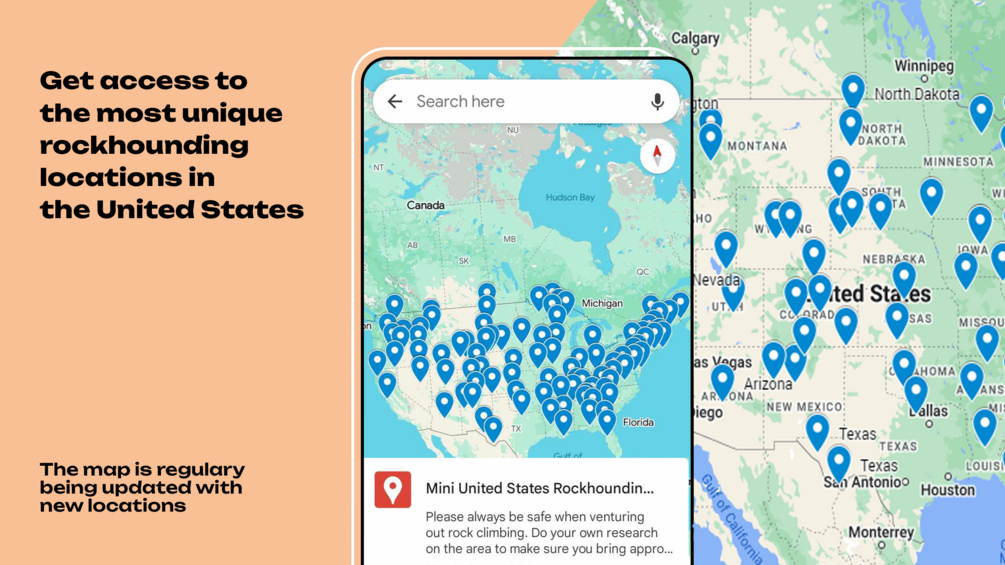Nebraska might not be the first place you think of when it comes to rockhounding, but it’s a hidden gem teeming with geological treasures.
Whether you’re a seasoned collector or a curious newbie, the Cornhusker State offers a surprising variety of finds.
From the chalky bluffs of the northwest to the rich riverbeds of the east, you’ll uncover fascinating specimens. Get ready to dig into Nebraska’s ancient past and maybe even take home a piece of it!
You might just find agates, fossils, or even the state’s unique Blue Agate.
Nebraska offers a unique rockhounding experience with locations like Niobrara River Valley for petrified wood, Keystone for Blue Agate, and the Ashfall Fossil Beds for ancient fossils. Explore the Fairburn agate, chalcedony, jasper, and fossils from the Miocene epoch across the state. Respect local regulations for a fulfilling experience.
Get our FREE United States Rockhounding Map HERE

Nebraska Rockhounding Locations
When you’re ready to start your rockhounding adventure in Nebraska, you’ll find there’s no shortage of places to explore. One of the top destinations is the scenic Niobrara River Valley, known for its abundance of petrified wood. The valley’s riverbanks are a prime spot for collectors, and you’re likely to uncover beautifully preserved specimens that are millions of years old.
Head over to Keystone if you’re in search of Nebraska’s famous Blue Agate. The area’s unique geology makes it an ideal location for finding these coveted stones. The Fairburn agate, although more common in South Dakota, also makes an appearance here, offering an exciting find for avid rockhounds.
Key Rockhounding Sites to Check Out
- Ashfall Fossil Beds: Discover remnants of ancient creatures in the volcanic ash preserved here.
- Warfield Fossils: This private quarry grants access for a fee and is rich in fossils.
- Agate Fossil Beds National Monument: Ideal for enthusiasts interested in both geology and paleontology.
What Might You Find?
As you survey these landscapes, keep your eyes peeled for a range of other geological treasures:
- Chalcedony
- Jasper
- Fossils from the Miocene epoch
- Native American artifacts
Without a doubt, Western Nebraska offers a wide array of collecting sites as well. The region, particularly around Harrison, is renowned for the presence of Prairie Agate. Prairie Agate is recognized by its red and yellow banding, and while you’re in the area, you might also encounter jasper and fossilized bones.
Remember to check local regulations and obtain permissions if necessary before rockhounding on public or private lands. Some sites may have specific guidelines or may require a small fee for access. Equipped with this information, you’re well on your way to a fulfilling rockhounding experience in Nebraska’s diverse geological playground.
What Gemstones are Found in Nebraska?

Nebraska may not be the first place you think of when it comes to dazzling gemstones, but you’ll be surprised at the treasures hidden in its terrain. The Cornhusker State holds a fascinating array of gems inviting both novice and seasoned rockhounds to explore its vast landscapes.
Fairburn Agate stands out as Nebraska’s state gemstone. Unearthed in the grassy plains, these agates are recognizable by their distinct, colorful banding and patterns. The search for these gems is akin to a treasure hunt, with the best finds often lying in the Chadron Formation’s layers, dating millions of years back.
In addition to Fairburn Agate, Nebraska yields the renowned Blue Agate, a variation of chalcedony. Blue Agate is cherished for its soothing ocean-like hues and swirling patterns. Seek out this gemstone in the areas around Keystone and you may find yourself in possession of a truly stunning specimen.
Rockhounders in Nebraska also have the chance to discover:
- Prairie Agate: Displaying earthy tones and often transparent sections
- Jasper: Valued for its intricate designs and variety of colors
- Quartz Crystals: Known for their clarity and geometric shapes
- Amber: Categorized by its warm, golden color that captures the essence of sunlight
As you venture through Nebraska’s landscapes, you’ll uncover a spectrum of gemstones that reflect the state’s geological diversity. Embark on excursions to areas like the scenic Niobrara River Valley or the fossil-rich deposits at Ashfall Fossil Beds, which could yield unexpected gemstone finds. Your patience and keen eye might reward you with a piece of Nebraska’s less-celebrated, yet equally captivating, gemstone heritage.
For the most successful rockhounding experience, it’s essential to carry the right tools, such as a sturdy hammer, chisels, and a good pair of gloves. Research the areas you plan to visit and arm yourself with local knowledge to spot the best potential rockhounding sites. And always remember, respect the land by adhering to the Leave No Trace principles to ensure these areas remain pristine for future generations of rockhound enthusiasts.
What Sedimentary Rocks You Can Find in Nebraska?

While you’re on your rockhounding adventure in Nebraska, you’ll encounter a variety of sedimentary rocks, each with its own unique features. Sedimentary rocks are typically formed by the accumulation and consolidation of mineral and organic particles, over time, on the Earth’s surface. Nebraska’s geological history has provided a bounty of these rocks that you can discover and collect.
Limestone is one of the most common sedimentary rocks you’ll find across Nebraska. It’s often formed from the skeletal fragments of marine organisms such as coral and foraminifera. Areas like Weeping Water are famous for limestone quarries, where you might also find fossils embedded within the rock.
Sandstone is another sedimentary rock you might come across. Formed by compacted sand over millions of years, the sandstone in Nebraska can range from fine to very coarse grains. Look for varying hues from light creams to deep reds, depending on the iron content. The Oglala National Grassland is a place where you can often spot these colored sandstones.
Shale, a fine-grained sedimentary rock formed from mud that’s a mix of clay minerals and tiny fragments of other minerals, is also present in Nebraska. You’re likely to find shale formations along river valleys and basins, signifying ancient environments that were once underwater.
Besides these, you may stumble upon rare chalcedony nodules contained within the sedimentary rock layers. These nodules are often spherical and can contain exquisitely arranged crystal structures when split open, offering a pleasant surprise to the avid collector.
Keep in mind the stratified layers of Nebraska’s rock formations often tell a story of the area’s prehistoric past. As you explore different regions within the state, pay attention to the layered patterns on exposed rock faces which can provide insights into the environmental conditions under which these rocks formed.
What Metamorphic Rocks are found in Nebraska?
While Nebraska is chiefly known for its sedimentary formations, metamorphic rocks are an underplayed character in the state’s geological narrative. Your journey into Nebraska’s rockhounding won’t be complete without a search for these transformed stones. Unlike sedimentary rocks, metamorphic rocks are the result of immense heat and pressure altering the original rock’s chemical structure.
Quartzite
One of the main metamorphic rocks you’ll come across in Nebraska is quartzite. Originally pure quartz sandstone, quartzite has undergone significant change to become the hard, glassy rock it is now. It’s identified by its resistance to weathering and can be found in hues ranging from pink to red, or even green if it contains iron.
Schist and Gneiss
Also, keep an eye out for schist and gneiss. These rocks demonstrate the extreme conditions they’ve endured through their unique textures and layering. Schist is characterized by its thin layers and ease of splitting, often shining from the mica content. Gneiss, on the other hand, has a more banded appearance, with alternating light and dark layers.
Here’s a quick overview of where you might find these rocks in Nebraska:
| Rock Type | Probable Locations |
|---|---|
| Quartzite | Sioux County, Dawes County |
| Schist | Sarpy County, Cass County |
| Gneiss | Frontier County, near the Missouri River |
Remember, while searching, it’s crucial to respect property rights and secure any necessary permissions. Many of these metamorphic finds can be seen in road cuts, river banks, and within Nebraska’s scenic state parks.
Rockhounding for metamorphic rocks in Nebraska not only adds variety to your collection but also connects you to the natural history and evolution of the landscape. Whether you’re admiring quartzite or analyzing the intricate patterns of gneiss and schist, you’re engaging with a part of Earth’s dynamic past that remains ever-present underfoot. Keep your tools handy and your eyes peeled; you never know when the perfect specimen will appear.
What Igneous Rocks can You Find in Nebraska?
In your quest for rockhounding treasures across Nebraska, you’ll discover that the Cornhusker State is also home to intriguing igneous rocks. While metamorphic rocks tell a story of transformation, igneous rocks take you back to the state’s fiery past.
Basalt and rhyolite are two of the igneous varieties you’re likely to encounter. Basalt forms from fast-cooling lava and is known for its dark, fine-grained appearance. In contrast, rhyolite comes from volcanic ash deposits and features a lighter color with a glassy texture. Both these rocks offer a unique peek into the volcanic activity that once shaped the region’s landscape.
Prime Locations for Igneous Rocks
- Indian Cave State Park: Explore the park’s trails and uncover pieces of rhyolite along the way. It’s a great spot for rockhounds looking to add volcanic rocks to their collection.
- Niobrara River Valley: This picturesque valley is where you can find basalt formations. The river cut through ancient lava flows, exposing rocks ripe for the picking.
When searching for these igneous specimens, ensure you’re not disrupting any natural habitats or geological sites. Always check local guidelines and obtain any required permits before starting your rockhounding adventure.
Identifying Your Finds
Understanding the characteristics of igneous rocks is crucial:
- Basalt is typically dense and black or dark gray.
- Rhyolite may appear light gray, green, or even pink and is often marked by a banded pattern due to its flow history.
To verify your finds, consider investing in a good field guide that details the properties of igneous rocks found in Nebraska. This will not only help in identification but also enrich your knowledge of the region’s geological heritage.
Armed with this information, your next rockhounding journey to Nebraska’s igneous landmarks will be filled with anticipation. Remember, each discovery holds a fragment of Earth’s fiery beginnings, adding a profound element to your rock collection.
Panning for Gold in Nebraska
If you’re looking for a glint of gold in your rockhounding adventures, Nebraska might surprise you. Long overshadowed by the famous gold rushes of California and Alaska, the Cornhusker State still holds hidden nuggets and fine gold for those willing to seek it out. Panning for gold in Nebraska primarily revolves around the rivers and streams in the western part of the state.
When you’re setting out to pan for gold, timing is crucial. Spring is often the best season due to higher water levels that stir up the riverbeds, unearthing the heavier materials where gold is found. Minatare Lake, near Scottsbluff, and the Niobrara River, close to Valentine, are some well-known spots where prospectors have had success in the past.
It’s important to note that much of the gold is very fine, so patience and technique are paramount. You’ll need a pan, a slotted shovel, and perhaps a sluice box to separate the gold from the silt. Don’t forget to check local regulations; some areas may require a permit for panning.
Here are a few more streams known for occasional gold findings:
- Bridgeport State Recreation Area
- Wildcat Hills State Recreation Area
- Bessey Ranger District of the Nebraska National Forest
You’ll want to focus on areas where heavier sediments are known to accumulate, such as the inside bends of creeks and riverbeds, downstream from boulders, or where streams slow down. The process can be meditative, with the rhythmic motion of swirling water in your pan, and a keen eye might spot the merest shimmer of gold amidst the sediment.
While you’re exploring Nebraska’s waters for gold, keep an eye out for other minerals and rocks that often signal the presence of gold, such as black sand (magnetite), quartz, and pyrite—sometimes dubbed “fool’s gold” for its deceptive luster. These indicators can guide you toward more productive spots for gold panning and enrich your understanding of the region’s mineralogy.
Rocks and Minerals Found in Nebraska
Nebraska’s diverse geology means there’s a rich variety of rocks and minerals awaiting your discovery. Beyond basalt and rhyolite, the state boasts an assortment of materials that’ll excite any rockhound.
Agates and jaspers are abundant and often found in the riverbeds and gravel pits around Nebraska. Indian Cave State Park, with its scenic trails and river access, presents an excellent spot for finding these colorful specimens. These silica-rich rocks come in a myriad of patterns and colors, each piece a testament to the unique geological processes that formed them.
As you traverse the terrain, you’re likely to encounter calcite crystals, especially within the limestone regions of the state. These transparent to translucent minerals are not only appealing to the eye but also signal an area rich in other minerals. Look for the honey-colored varieties often found in the eastern counties.
Don’t overlook the potential for fossil finds either. Nebraska was once a vast inland sea, leaving behind fossilized remnants like shark teeth and Ammonites, particularly in areas like the Ashfall Fossil Beds. Such discoveries provide a glimpse into an ancient world and are a gratifying addition to any rockhound’s collection.
If you’re interested in unearthing a geological treasure trove, Knox County is the place to be. Here, the Niobrara Chalk Formations hold not only visual appeal but also paleontological significance, housing both minerals and fossils within its layers.
For those with a penchant for the peculiar, zeolites, minerals usually formed from the alteration of volcanic ash, are found in southeastern areas of Nebraska. Known for their ability to exchange ions and their crystalline structures, zeolites possess both beauty and scientific intrigue.
| Mineral | Likely Locations | Notable Characteristics |
|---|---|---|
| Agates | Riverbeds, Gravel Pits | Colorful, Patterned |
| Jaspers | Indian Cave State Park | Diverse Colors |
| Calcite Crystals | Eastern Counties | Translucent, Honey-Colored |
| Fossils (Shark Teeth, Ammonites) | Ashfall Fossil Beds | Paleontological Significance |
| Zeolites | Southeastern Nebraska | Ion-Exchange Capability |
Remember, while rockhounding can be a rewarding adventure, always ensure that you’re collecting responsibly.
Where Can I Find Fossils in Nebraska?
Nebraska’s rich geologic history means you’re in a prime spot for fossil hunting. When you’re on the lookout for these treasures from the past, Ashfall Fossil Beds State Historical Park should be at the top of your list. It’s a world-renowned site where you can find well-preserved remains of ancient animals that perished in volcanic ash 12 million years ago.
But that’s not your only option. The Niobrara River Valley is famous for housing fossils of prehistoric marine life due to its past as part of an inland sea. Here, enthusiasts often uncover remains such as clams, snails, and even ancient sharks’ teeth.
You might also want to explore the badlands near Toadstool Geologic Park. This area is akin to a natural museum where wind and water erosion have uncovered a wealth of fossilized plants and animals. Hikers frequently report finding fascinating evidence of creatures that once roamed the landscape.
Before setting out on your fossil hunt, keep in mind that certain locations are protected, and collecting fossils may require a permit. Always confirm with local authorities to ensure adherence to state laws and preservation efforts.
Remember to arm yourself with the appropriate tools for excavation and take great care not to damage the fossils. Gentle brushes and small picks are your best bet for revealing these hidden pieces of history without harm.
When planning your trip, consider visiting during drier seasons; this is when erosion is most likely to have exposed new fossils. Also, keep an eye on recent digs or construction work in the area – these can often lead to exciting new finds.
By familiarizing yourself with the terrain and respecting the rules of responsible collecting, you’ll heighten your chances of uncovering Nebraska’s fossilized secrets. Whether it’s the vertebrates of Ashfall or the marine life of the Niobrara, you’re sure to embark on an unforgettable journey into the ancient past.
Nebraska Rockhounding Laws & Regulations
When planning your rockhounding trip in Nebraska, it’s essential to be aware of the laws and regulations governing this activity. Nebraska Game and Parks Commission oversees these laws, designed to protect the natural and historical resources of the state. Before you start your adventure, make sure you’re familiar with the requirements to ensure your rockhounding is legal and responsible.
Land Access: First and foremost, always obtain permission before entering private land. When it comes to public lands, such as state parks or national forests, rockhounding may be permitted but often with strict limitations.
- Collection Limits: On public lands, there might be daily limits on the quantity and type of materials you can collect. For instance, you’re typically allowed to collect small amounts of rocks and minerals for personal use only—commercial collecting is prohibited.
- No Disturbance Zones: Some areas may be designated as protected, where removal of any natural object is forbidden. Keep an eye out for signs indicating these zones.
Permit Requirements: In certain locations, such as state parks and historical sites, you may need a permit for rockhounding. This rule ensures that collectors don’t accidentally damage sensitive environments or archaeological sites.
- Fossil Collection: Fossil collecting often has its own set of rules. For example, at the Ashfall Fossil Beds, collecting is strictly prohibited. Ensure you check the regulations specific to fossil collection before you head out.
Tool Restrictions: Usage of tools is generally allowed, but there might be restrictions on the types of tools you can use. For example, hand tools like hammers and shovels are permissible, but power tools or explosives are usually off-limits.
Environmental Conservation: Always practice the “Leave No Trace” principles. This encourages rockhounders to preserve the natural landscape for future generations by minimizing their impact on the environment.
Adhering to these guidelines not only keeps you within the law but also helps to protect Nebraska’s rich geological heritage. Remember, when in doubt, reach out to local governing bodies for the most current information on rockhounding laws and regulations. Always prioritize the preservation of the environment while enjoying the treasure hunt Nebraska has to offer.
Rockhounding Tips for Beginners in Nebraska
Gearing Up: Essential Tools for Rockhounding
Before you head out on your Nebraska rockhounding adventure, it’s crucial to have the right gear. A good-quality geologist hammer is your fundamental tool, perfect for chipping and breaking rocks. Additionally, a chisel can help extract samples from larger stones. Don’t forget safety goggles to protect your eyes from flying debris. Comfort is also important, so a sturdy pair of gloves will prevent cuts on your hands.
Carrying a magnifying glass enables you to inspect potential finds on the spot. As you’ll likely stumble upon tiny specimens, having small containers or ziplock bags for storing your treasures is a smart move. For navigation, consider using a GPS device or a detailed map; Nebraska’s terrain can be sprawling and disorienting. Lastly, a backpack or a sturdy bucket offers convenient carry-all for your collected specimens and tools.
Safety Tips While Rockhounding
Rockhounding can be as safe as it is enjoyable, provided you take certain precautions. Always inform someone of your whereabouts and expected return time. Due to variable weather conditions in Nebraska, wear layered clothing and pack sunscreen and a hat to fend off sunburn.
Hydration is key, so carry ample water, especially during the summer months. Insect repellent will be your ally against bugs. Be vigilant of your surroundings; snakes and other wildlife in Nebraska require a respectful distance.
While exploring, watch your footing, particularly in rocky or slippery areas. Avoid overexerting yourself, and remember, if you’re not confident in extracting a specimen, it’s better to leave it be than risk injury.
Legal Guidelines for Rockhounding Enthusiasts
Responsible rockhounding means following local laws to ensure the preservation of our geological wonders. In Nebraska, gaining landowner permission before collecting on private property is non-negotiable. On public lands, be aware of collection limits, and stick to them.
Certain areas may require a permit; always check with local authorities beforehand. While it might be tempting to use metal detectors or excavation tools, remember that tool restrictions often apply. Research these restrictions to avoid legal complications or inadvertently damaging sensitive geological formations.
Preserving Nebraska’s natural heritage also includes adhering to a leave-no-trace philosophy. Pack out what you pack in, disrupt nothing, and take only photographs of sensitive ecological areas and archaeological sites. Embrace rockhounding with a conservationist spirit, keeping Nebraska’s landscape as pristine as you found it for future generations to enjoy.
Conclusion: Nebraska Rockhounding Map
Embarking on your rockhounding adventure in Nebraska, you’re now equipped with the knowledge of what treasures lie beneath the surface and where to find them.
Remember to pack your essential tools, follow the legal guidelines, and always collect with respect for the environment. Whether you’re drawn to the glistening agates, the ancient fossils, or the myriad of other minerals, Nebraska’s diverse landscapes await. Keep your eyes peeled for new opportunities that may arise from recent digs or construction, and don’t forget to check in with local authorities for the latest on rockhounding regulations.
Happy hunting!




![ND Rockhounding Sites in [year]: Treasures & Finds](https://observationhobbies.com/wp-content/uploads/2024/01/NXhSmnQX-d6GEwx7lYbig-768x439.jpg)

![Delaware Rockhounding Sites in [year]: Location & Hidden Gems](https://observationhobbies.com/wp-content/uploads/2024/01/OlSBM_jZS8pYfIDXCzqu-768x439.jpg)
